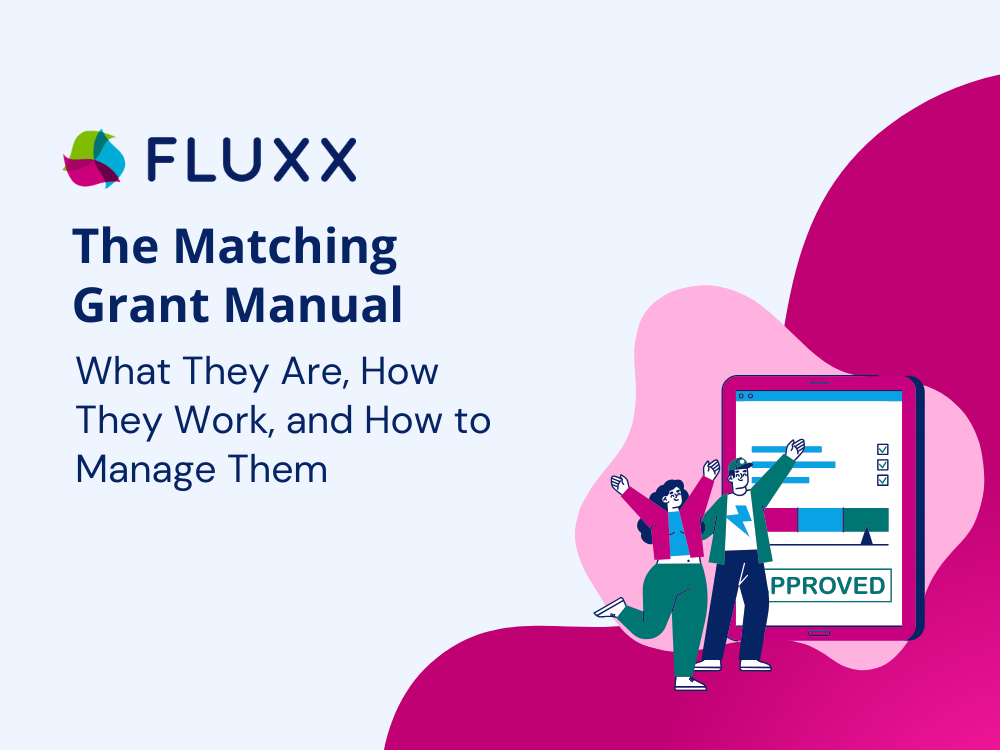The Corporate Giving Software Use Case
Discover how corporate giving software streamlines employee giving, donation matching, and grantmaking. Learn how it differs from and integrates with...
Be the first to know about new Fluxx grants management resources, blog articles and podcasts.


Matching grant programs are a powerful fundraising and engagement tool used by funders to multiply impact and encourage broader community support. For nonprofits, understanding how these programs function—and how to manage them efficiently—is key to unlocking more funding, increasing donor engagement, and demonstrating credibility to stakeholders.
As distinguished from conventional grants that tend to arrive as a single, fixed contribution, matching grants are dynamic in that they compel the nonprofit organization to take an active part in seeking other funds. Not only does the model of mutual responsibility enlarge the financial capability but also stimulate increased community engagement and publicity. Whether you are a newcomer to matching grants or juggle several campaigns simultaneously, the right structure and resources can spell the difference.
A matching grant is a funding arrangement in which a grantor agrees to match funds raised by the grantee, typically at a predetermined ratio. The match might be dollar-for-dollar or based on another formula (e.g., $2 for every $1 raised).
The purpose of matching grants is to encourage grantees—usually nonprofits—to raise funds from other sources, expanding the donor base and increasing overall impact. Matching grants are often used in capital campaigns, emergency response initiatives, or annual fundraising drives.
A matching grant's basic mechanism is conditional funding: the grantor will give only if the grantee can raise a stipulated amount from other donors or sources within a specific time span.
This is how a standard matching grant process proceeds:
Matching grants may also include stipulations such as minimum individual donation amounts, eligible donor types, or allowable fundraising methods.
Matching grants offer long-term dividends—both fiscally and strategically. To nonprofit organizations, they are an attractive resource to stimulate contributions, raise momentum, and show financial responsibility. To funders, they raise the rate of return on charitable investment by engaging greater numbers of community members and distributing support over a broader base.
Some of the most important advantages are:
As University of Chicago Booth School of Business research demonstrates, matching grants can increase the amount a nonprofit receives from individual contributions by up to 20% if applied strategically (source).
Matching grants aren’t one-size-fits-all. Funders design them with different structures depending on the outcomes they want to drive and the capacity of the organizations involved. Understanding the type of match structure you’re working with is critical to executing a successful campaign and meeting expectations.
Some common include:
Understanding the match structure helps nonprofits plan effective campaigns and track progress correctly.
Suppose a regional food bank is awarded a matching grant by a corporate foundation:
During the campaign, the food bank secures individual contributions totaling $80,000. After presenting paperwork to the foundation, the food bank is given the full $75,000 match—increasing the campaign total to $155,000.
This surge underpins increased holiday food distribution campaigns throughout the area, as it shows stakeholders the capability of the food bank to garner wide community support.
Matching grants are very popular in every nonprofit area because they have the possibility of stretching gifts and gaining higher participation. Organizations that apply tend to have strong fundraising capability or access to a loyal constituency of givers.
Applicants usually include:
What these applicants have in common is their potential to mobilize a constituency around an issue—a hallmark of a highly effective matching grant campaign.
Working with a matching grant is not a straightforward matter of tracking pledges but requires precision, up-to-the-minute logistics, and conformity with the rules of the donors. Nonprofits can handle the complete life cycle of a matching campaign with Fluxx within a specially designed environment created just for the purpose of openness and accountability.
Fluxx enables fundraising teams to track contributions against match objectives in real time, confirm contribution eligibility criteria, and administer communications between departments. Campaign timelines, donor information, and documentation are combined into a single integrated system. This enables your finance and development teams to work off the same set of data, preventing duplication and producing instant reports to funders demonstrating both donor activity and match success. From setup at the beginning to disbursement at the end, Fluxx ensures every aspect within a matching grant is managed efficiently and in compliance with funder specifications.
Matching grants don’t just add dollars to a budget—they create momentum. They engage your donor base, amplify funder contributions, and catalyze large-scale giving. But they also require structure, discipline, and accountability to execute effectively.
With the right tools—like Fluxx—your nonprofit can confidently manage matching campaigns, demonstrate outcomes, and build deeper funder and donor trust. Whether you're applying for your first match or scaling a multi-campaign strategy, Fluxx equips you to turn matching grants into mission momentum.
Schedule a demo today and discover how Fluxx drives performance from match to impact.
Discover how corporate giving software streamlines employee giving, donation matching, and grantmaking. Learn how it differs from and integrates with...
Learn effective state funding management tips for government agencies, the differences between state funding and grants, and how to streamline the...
Discover what Grants.gov is, how it works, the types of grants available, and how to use the platform effectively. Learn how Fluxx integrates with...
Be the first to know about new Fluxx grants management resources, blog articles and podcasts.